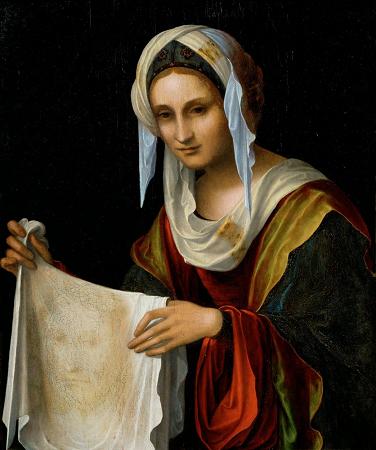Veil of Veronica. The Veil of Veronica, or Sudarium, often called simply The Veronica and known in Italian as the Volto Santo or Holy Face, is a Christian relic of a piece of cloth which, according to tradition, bears the likeness of the face of Jesus not made by human hand. Various existing images have been claimed to be the original relic, or early copies of it. The final form of the Western tradition recounts that Saint Veronica from Jerusalem encountered Jesus along the Via Dolorosa on the way to Calvary. When she paused to wipe the blood and sweat off his face with her veil, his image was imprinted on the cloth. The event is commemorated by the Sixth Station of the Cross. According to some versions, St. Veronica later traveled to Rome to present the cloth to the Roman Emperor Tiberius, and the veil, possessing the Grace of God, was able to quench thirst, cure blindness, and even raise the dead. The story is not recorded in its present form until the Middle Ages. During the fourteenth century it became a central icon in the Western Church; in the words of art historian Neil Macgregor: From on, wherever the Roman Church went, the Veronica would go with it. The act of Saint Veronica wiping the face of Jesus with her veil is celebrated in the sixth Station of the Cross in many Anglican, Catholic, Lutheran, Methodist and Western Orthodox churches. There is no reference to the story of Veronica and her veil in the canonical Gospels. The closest written reference is the miracle of Jesus healing the bleeding woman by touching the hem of Jesus' garment; her name is later identified as Veronica by the apocryphal Acts of Pilate. The story was later elaborated in the 11th century by adding that Christ gave her a portrait of himself on a cloth, with which she later cured Tiberius. The linking of this with the bearing of the cross in the Passion, and the miraculous appearance of the image, was made by Roger d'Argenteuil's Bible in French in the 13th century, and gained further popularity following the internationally popular work Meditations on the Life of Christ of about 1300. It is also at this point that other depictions of the image change to include a crown of thorns, blood, and the expression of a man in pain, and the image became very common throughout Catholic Europe, forming part of the Arma Christi, and with the meeting of Jesus and Veronica becoming one of the Stations of the Cross. On the Via Dolorosa in Jerusalem there is a small chapel, known as the Chapel of the Holy Face. Traditionally, this is regarded as the home of St Veronica and site of the miracle. According to the Catholic Encyclopedia, the name Veronica is a colloquial portmanteau of the Latin word vera, meaning truth, and Greek icon, meaning image; the Veil of Veronica was therefore largely regarded in medieval times as the true image, and the truthful representation of Jesus, preceding the Shroud of Turin. There was a physical image displayed in Rome in the thirteenth, fourteenth and fifteenth centuries which was known and venerated as the Veil of Veronica. However, the history of that image is somewhat problematic. It has often been assumed that the Veronica was present in the Old St Peter's in the papacy of John VII, as a chapel known as the Veronica chapel was built during his reign, and this seems to have been the assumption of later writers. However, this is far from certain, as mosaics that decorated that chapel do not refer to the Veronica story in any way. Furthermore, contemporaneous writers make no reference to the Veronica in this period. It would appear however that the Veronica was in place by 1011 when a scribe was identified as keeper of the cloth. Firm recording of the Veronica only begins in 1199 when two pilgrims, Gerald de Barri and Gervase of Tilbury, made two accounts at different times of a visit to Rome, making direct reference to the existence of the Veil of Veronica. Shortly after that, in 1207, the cloth became more prominent when it was publicly paraded and displayed by Pope Innocent III, who also granted indulgences to anyone praying before it. This parade, between St Peter's and the Santo Spirito Hospital, became an annual event and on one such occasion in 1300 Pope Boniface VIII, who had it translated to St. Peter's in 1297, was inspired to proclaim the first Jubilee in 1300. During this Jubilee the Veronica was publicly displayed and became one of the Mirabilia Urbis for the pilgrims who visited Rome.
more...






